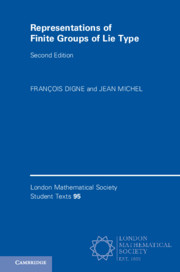Book contents
- Frontmatter
- Contents
- Introduction to the Second Edition
- From the Introduction to the First Edition
- 1 Basic Results on Algebraic Groups
- 2 Structure Theorems for Reductive Groups
- 3 (B,N)-Pairs; Parabolic, Levi, and Reductive Subgroups; Centralisers of Semi-simple Elements
- 4 Rationality, the Frobenius Endomorphism, the Lang–Steinberg Theorem
- 5 Harish-Chandra Theory
- 6 Iwahori–Hecke Algebras
- 7 The Duality Functor and the Steinberg Character
- 8 ℓ-Adic Cohomology
- 9 Deligne–Lusztig Induction: The Mackey Formula
- 10 The Character Formula and Other Results on Deligne–Lusztig Induction
- 11 Geometric Conjugacy and the Lusztig Series
- 12 Regular Elements; Gelfand–Graev Representations; Regular and Semi-Simple Characters
- 13 Green Functions
- 14 The Decomposition of Deligne–Lusztig Characters
- References
- Index
- References
References
Published online by Cambridge University Press: 14 February 2020
- Frontmatter
- Contents
- Introduction to the Second Edition
- From the Introduction to the First Edition
- 1 Basic Results on Algebraic Groups
- 2 Structure Theorems for Reductive Groups
- 3 (B,N)-Pairs; Parabolic, Levi, and Reductive Subgroups; Centralisers of Semi-simple Elements
- 4 Rationality, the Frobenius Endomorphism, the Lang–Steinberg Theorem
- 5 Harish-Chandra Theory
- 6 Iwahori–Hecke Algebras
- 7 The Duality Functor and the Steinberg Character
- 8 ℓ-Adic Cohomology
- 9 Deligne–Lusztig Induction: The Mackey Formula
- 10 The Character Formula and Other Results on Deligne–Lusztig Induction
- 11 Geometric Conjugacy and the Lusztig Series
- 12 Regular Elements; Gelfand–Graev Representations; Regular and Semi-Simple Characters
- 13 Green Functions
- 14 The Decomposition of Deligne–Lusztig Characters
- References
- Index
- References
Summary

- Type
- Chapter
- Information
- Representations of Finite Groups of Lie Type , pp. 249 - 254Publisher: Cambridge University PressPrint publication year: 2020

